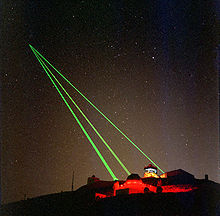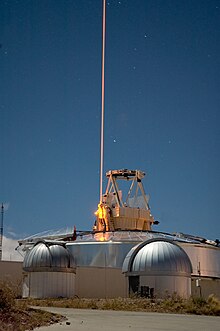Starfire Optical Range



Die Starfire Optical Range ist ein Forschungslabor der United States Air Force, das sich in der Kirtland Air Force Base in Albuquerque (New Mexico) befindet. Gemäß ihrer Homepage arbeitet es an der „Entwicklung und Demonstration von Techniken zur Kontrolle optischer Wellenfronten“. Die Anlage ist ein Sicherheitstrakt und bildet eine Einrichtung des „Directed Energy Directorate“ des Air Force Research Laboratory.

Zu ihren optischen Ausrüstung gehören ein
- 3,5-Meter-Spiegelteleskop, seit 1994 in Betrieb und seit 1997 ausgestattet mit einer adaptiven Optik, ein
- 1,5-Meter-Teleskop, und ein
- Laseremitter mit einer Apertur von 1,0 Meter,
wobei erstere auch gelegentlich für astronomische Untersuchungen verwendet werden.[1][2]
Militärische Nutzung
Laut einem Artikel der New York Times vom 3. Mai 2006 wird in der Einrichtung an einem Verfahren geforscht, die das Ausschalten von Satelliten mittels bodengestütztem Laser ermöglichen soll. Entsprechende Dokumente zur Budgetbeschaffung wären dem US-Kongress vorgelegt worden. Ein solches System entspräche einer Energiewaffe oder einer Weltraumwaffe.
Weblinks
- Starfire Optical Range auf der Seite globalsecurity.org (englisch)
- Einrichtungen der Starfire Optical Range (Memento vom 5. Februar 2007 im Internet Archive) (englisch)
- Starfire Optical Range at Kirtland Air Force Base, New Mexico (englisch)
- Administration Researches Laser Weapon. Artikel der NY Times vom 3. Mai 2006 (englisch)
Einzelnachweise
- ↑ Barnaby, David; Spillar, Earl; Christou, Julian C.; Drummond, Jack D.: Measurements of Binary Stars with the Starfire Optical Range Adaptive Optics Systems. In: The Astronomical Journal. 119. Jahrgang, Nr. 1, S. 378–389, doi:10.1086/301155, bibcode:2000AJ....119..378B.
- ↑ Drummond, Jack D.: Binary Stars Observed with Adaptive Optics at the Starfire Optical Range. In: The Astronomical Journal. 147. Jahrgang, Nr. 3, 2014, doi:10.1088/0004-6256/147/3/65, bibcode:2014AJ....147...65D.
Koordinaten: 34° 57′ 50,4″ N, 106° 27′ 46,8″ W
Auf dieser Seite verwendete Medien
The 3.5 meter telescope facility is expected to become one of the world's most capable for obtaining ultra-high resolution images at visible wavelengths. Near diffraction limited performance (in the 0.6-1.0 micron wavelength region and to an apparent visual magnitude limit greater than tenth) will be achieved within the next few years through the use of high-order adaptive optics and a sodium wavelength laser beacon. First light with the adaptive optics installed was achieved in September of 1997. View the binary star image taken on the 3.5m telescope with adaptive optics. Much attention has also been directed at minimizing thermally-induced turbulence throughout the 3.5 meter telescope facility. The outstanding example of this effort is a fully collapsible telescope enclosure. The facility is cooled by a closed-cycle water system chilled by ice stored underground, away from the facility. The 3.5 meter telescope is a classical Cassegrainian optical design with a coudé path. Sensors and other auxiliary instrumentation can be mounted at one of two Naysmyth optical breadboards on the telescope itself or in one of several coudé laboratories.



